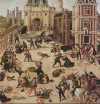First appearing in the late 19th c. but particularly prevalent after WWII, when many Pacific Islanders witnessed airdrops of supplies, cargo cults are the unorthodox religious movements that appeared in tribal societies after interaction with Westerners. Believing fallen cargo came from divine spirits who would send more upon seeing rituals based on the foreigners’ behavior, the tribes built straw airplanes, radios made of coconuts, and other pseudo-Western items. Do any cargo cults exist today? Discuss
Source: The Free Dictionary
 Long sought as the “holy grail” of Western alchemy, the philosopher’s stone is a legendary substance that is supposedly capable of turning inexpensive metals into gold and is believed by some to have the power to restore youth. At one time, alchemists believed a key ingredient of the stone was a mythical element called “carmot.” According to legend, to whom did 13th-century scientist Albertus Magnus give the philosopher’s stone after discovering it shortly before his death?
Long sought as the “holy grail” of Western alchemy, the philosopher’s stone is a legendary substance that is supposedly capable of turning inexpensive metals into gold and is believed by some to have the power to restore youth. At one time, alchemists believed a key ingredient of the stone was a mythical element called “carmot.” According to legend, to whom did 13th-century scientist Albertus Magnus give the philosopher’s stone after discovering it shortly before his death?  In antiquity, Phrygia was a kingdom in the west-central part of the Anatolia, the site of modern Turkey. The Phrygian people settled in the area around 1200 BCE and established a kingdom in the 8th century BCE before being conquered and becoming part of the Persian, Greek, and Roman empires. Phrygia developed an advanced Bronze Age culture and the earliest traditions of Greek music were derived from the area. Who was the mythic Phrygian king who was given the “golden touch”?
In antiquity, Phrygia was a kingdom in the west-central part of the Anatolia, the site of modern Turkey. The Phrygian people settled in the area around 1200 BCE and established a kingdom in the 8th century BCE before being conquered and becoming part of the Persian, Greek, and Roman empires. Phrygia developed an advanced Bronze Age culture and the earliest traditions of Greek music were derived from the area. Who was the mythic Phrygian king who was given the “golden touch”?  In Korea, the tradition of brewing alcoholic beverages, known as ju, is a long and proud one. These beverages are generally made from rice, a major Korean crop. The many varieties of ju include liquors and fruit, flower, and medicinal wines. One variety, called ihwaju, or “pear blossom wine,” is brewed with rice malt fermented during the pear blossom season, a process that often produces a liquid so thick that it must be consumed in what way?
In Korea, the tradition of brewing alcoholic beverages, known as ju, is a long and proud one. These beverages are generally made from rice, a major Korean crop. The many varieties of ju include liquors and fruit, flower, and medicinal wines. One variety, called ihwaju, or “pear blossom wine,” is brewed with rice malt fermented during the pear blossom season, a process that often produces a liquid so thick that it must be consumed in what way?  Kefir is a fermented milk drink that originated in the Caucasus region of Eurasia and is prepared by inoculating cow, goat, or sheep’s milk with kefir grains, a combination of bacteria and yeasts in a matrix of proteins, lipids, and sugars. Traditional kefir was made in skin bags that were hung near a doorway and knocked by everyone passing through to help keep the milk and kefir grains mixed. Today, kefir is popular due to research into its health benefits. What are these benefits?
Kefir is a fermented milk drink that originated in the Caucasus region of Eurasia and is prepared by inoculating cow, goat, or sheep’s milk with kefir grains, a combination of bacteria and yeasts in a matrix of proteins, lipids, and sugars. Traditional kefir was made in skin bags that were hung near a doorway and knocked by everyone passing through to help keep the milk and kefir grains mixed. Today, kefir is popular due to research into its health benefits. What are these benefits? %2c_Nordisk_familjebok.png) The idea of creating a weapon by attaching a sharp end to a long shaft is an old one—the first spears date back to the Stone Age. Over the centuries, pole weapons have taken many different forms, from the European fauchard to the Chinese guan dao to the Japanese naginata. Masses of soldiers carrying pole weapons were recognized as effective military units early in the history of organized warfare. What infantry weapon resembled a kitchen knife?
The idea of creating a weapon by attaching a sharp end to a long shaft is an old one—the first spears date back to the Stone Age. Over the centuries, pole weapons have taken many different forms, from the European fauchard to the Chinese guan dao to the Japanese naginata. Masses of soldiers carrying pole weapons were recognized as effective military units early in the history of organized warfare. What infantry weapon resembled a kitchen knife?  With a name meaning “killers of monarchs,” the Monarchomachs were originally members of the Protestant Reformed Church of France who opposed absolute monarchy at the end of the 16th century. Born out of the wars between Catholics and Protestants, the Monarchomachs promoted a theory of tyrannicide—the killing or assassination of tyrants for the common good—in their advocacy of popular sovereignty. What separated their political vision from the modern conception of democracy?
With a name meaning “killers of monarchs,” the Monarchomachs were originally members of the Protestant Reformed Church of France who opposed absolute monarchy at the end of the 16th century. Born out of the wars between Catholics and Protestants, the Monarchomachs promoted a theory of tyrannicide—the killing or assassination of tyrants for the common good—in their advocacy of popular sovereignty. What separated their political vision from the modern conception of democracy?  Used by judges, presiding officers, and auctioneers, gavels are small ceremonial mallets often struck against a block to call for attention or punctuate rulings. Because it is often used forcefully and therefore broken, the gavel in the US House of Representatives is plain, wooden, and easily replaced. The US Senate gavel is made of solid ivory and is actually a replica. Which US Vice President splintered the original—which had been used since 1789—during a heated debate on nuclear energy?
Used by judges, presiding officers, and auctioneers, gavels are small ceremonial mallets often struck against a block to call for attention or punctuate rulings. Because it is often used forcefully and therefore broken, the gavel in the US House of Representatives is plain, wooden, and easily replaced. The US Senate gavel is made of solid ivory and is actually a replica. Which US Vice President splintered the original—which had been used since 1789—during a heated debate on nuclear energy?  Before the invention of modern navigational tools, sailors in the ancient world navigated sea routes using periploi, documents that list ports, coastal landmarks, and the approximate distances between them. The Greek Periplus of the Erythraean Sea, dated between the first and third century CE, details navigation and trading opportunities at Roman Egyptian ports on the Red Sea and along the coasts of E Africa and India. According to the document, where is the “Frankincense kingdom”?
Before the invention of modern navigational tools, sailors in the ancient world navigated sea routes using periploi, documents that list ports, coastal landmarks, and the approximate distances between them. The Greek Periplus of the Erythraean Sea, dated between the first and third century CE, details navigation and trading opportunities at Roman Egyptian ports on the Red Sea and along the coasts of E Africa and India. According to the document, where is the “Frankincense kingdom”?